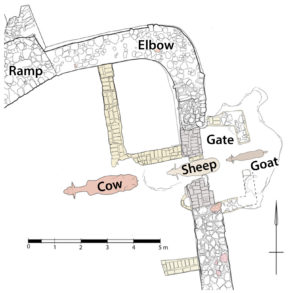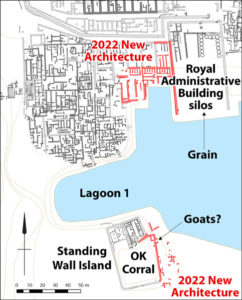 For many years we’ve thought Lagoon 1, the low-lying area at the southern end of the Lost City (Heit el-Ghurab) site, was once an ancient harbor that was used to deliver supplies to the city via the Nile.
For many years we’ve thought Lagoon 1, the low-lying area at the southern end of the Lost City (Heit el-Ghurab) site, was once an ancient harbor that was used to deliver supplies to the city via the Nile.
To the north of this proposed harbor, we found a series of large silos in the Royal Administrative Building in 2001. This is where grain was stored before it was turned into bread and beer to feed the pyramid workers.
To the south, we discovered the Standing Wall Island. In 2011, we found this compound contained a large, enclosed open area with a paperclip-like entrance that formed a chute. This enclosure seemed like it could be a stockyard where cattle were held, before being butchered to provide meat for the pyramid workers. We even started calling it the OK (Old Kingdom) Corral.
However, the corral’s actual entrance, along with the southern half of the silo building and most of the proposed harbor, ran under a modern soccer field, leaving us unable to see a large and crucial portion of our site.
 This year we got permission to start excavating the old soccer field and we hoped to finally prove our harbor and corral hypotheses. But when we went to “ground truth” the corral entrance, we found something unexpected!
This year we got permission to start excavating the old soccer field and we hoped to finally prove our harbor and corral hypotheses. But when we went to “ground truth” the corral entrance, we found something unexpected!
When we excavated the northeastern corner of the OK Corral that was previously under the soccer field, we found the wall formed an “elbow,” which turned and attached to a ramp at the north end of the corral. Near the elbow was a small gated opening, not the large open chute we had expected to find.
Could cattle have still come through this gate into the enclosed area? Though the entrance was originally 2.9 m wide, it looks like it was almost immediately narrowed to 0.85 m, and then again down to 0.56 m.
 While it’s possible that smaller cattle could get through, it would be a tight fit. At this point an animal pen is still the best explanation for the enclosure, but was it meant for cattle?
While it’s possible that smaller cattle could get through, it would be a tight fit. At this point an animal pen is still the best explanation for the enclosure, but was it meant for cattle?
The Lost City was in its heyday during the reigns of Khafre and Menkaure, the builders of the Second and Third Giza Pyramids. When Menkaure died, he left his pyramid and temples incomplete. Though his successor, Shepseskaf, completed the monuments, he moved away from Giza to build his own tomb at Saqqara.
Our new excavations show the OK Corral’s enclosure wall was actually a late addition to the building. With only a smaller workforce left behind at Giza after Menkaure’s death, is it possible the people who remained started to receive mostly sheep and goats, lower status meat than cattle? And that the corral was remodeled with a new gate for smaller livestock?
 How many and what type of animals the pyramid workers ate may seem like a small detail, but it’s details like this that ultimately help us piece together the lives of the people who built the pyramids and find out what happened to them once the Egyptian state’s focus shifted elsewhere.
How many and what type of animals the pyramid workers ate may seem like a small detail, but it’s details like this that ultimately help us piece together the lives of the people who built the pyramids and find out what happened to them once the Egyptian state’s focus shifted elsewhere.
Our motto is that we are not looking for things, we are looking for information. So we’ll follow the facts wherever they take us when we return to the Soccer Field area.
The full story of our recent work at the Soccer Field area and the Menkaure Valley Temple will be covered in future AERAgrams and our Annual Report.
Join AERA now to help support our ongoing excavations in Egypt and you will receive these publications as soon as they are published.
